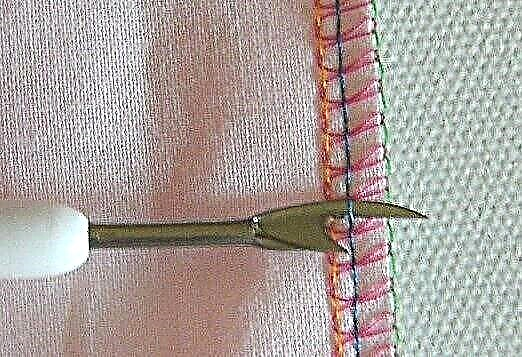Share
Pin
Tweet
Send
Share
Send
The choice of fasteners should be treated with special attention. Summer is in full swing! It's time to talk about the fastener on the air loops.
The fastener must first of all correspond to the material and purpose of the product. For blouses, dresses made of silk and cotton batiste or other delicate fabrics, there is nothing better and more feminine than air loops. A long fastener on the back not only emphasizes the beautiful line, but also serves as an ornament.Air clasp hinges can be made of steering wheel. The rulic is sewn from a slanting inlay or replaced with a round braid. There is also a ready-made braid with loops on sale, which can be sewn when processing the side of the fastener. A thin satin cord is also recommended. In this case, hat gum is used, thin and soft. She really fit into the flowery of the main material of the dress.
So, we sew thin steering wheel.Cut out the oblique collar strictly at an angle of 45 degrees to the warp thread 2.5–3 cm wide. Fold in half along the front side inwards. If the fabric is thin, then sew a line along the longitudinal sections at a distance of 3 mm from the fold, from thicker fabrics, at a distance of up to 5 mm. Leave the end of the part extended for ease of turning. Cut allowances close to the line. If the fabric is very thin slanting inlay it is better to double and the allowances do not cut close,so that the loop turns out to be “filled.” You can twist the tape in this way: thread the needle into a darn needle and tie it with a strong knot. Fasten it to the end of the tape. Stretch the needle forward through the steering wheel. The finished steering is slightly pulled over the steam (do not iron!).
How to make a fastener from separate loops.First of all, it is necessary to set the length of one loop. It depends on the size of the button and is equal to half the circumference of the button plus the seam allowance. Pinned or stitched cut loops to a side cut on the front side of the fabric according to the marking (Fig. 1).



 Alternatively, you can fix them with tape. Chip off the sideboard with the side (in this case, turning) with the sides inward (Fig. 2) and grind. Sweep the inside / edge and iron (Fig. 3). If desired, stitch the board. Sew buttons on the left side. In this case, these are wooden beads to emphasize the color scheme and the naturalness of the materials in creating a retro eco-dress for the baby! The dress in all angles can be seen here //www.burdastyle.ru/foto/retro-eko-plate-dlya-malyshki.
Alternatively, you can fix them with tape. Chip off the sideboard with the side (in this case, turning) with the sides inward (Fig. 2) and grind. Sweep the inside / edge and iron (Fig. 3). If desired, stitch the board. Sew buttons on the left side. In this case, these are wooden beads to emphasize the color scheme and the naturalness of the materials in creating a retro eco-dress for the baby! The dress in all angles can be seen here //www.burdastyle.ru/foto/retro-eko-plate-dlya-malyshki.I hope the information will be useful! Good luck
Share
Pin
Tweet
Send
Share
Send



